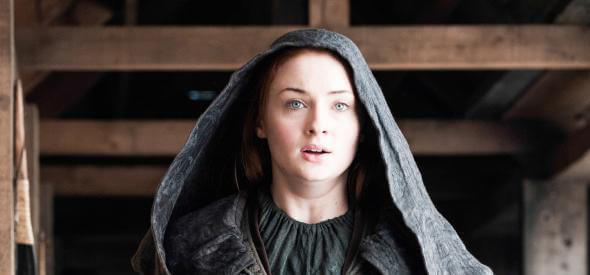

Abuse
The Unsung Badassery of Sansa Stark
The ‘Game of Thrones’ princess is just as tough as 'Mad Max’s’ Furiosa. So why don’t we see her prevail?
This article was made possible because of the generous support of DAME members. We urgently need your help to keep publishing. Will you contribute just $5 a month to support our journalism?
One of the bravest acts I’ve ever seen in film—let alone a summer blockbuster—depicts a young woman opening the back door to a big rig that is grinding and racing over a desert Hellscape and letting her heavily pregnant body hang between her comrade in the driver’s seat and the warlord who is pursuing them. The woman, Splendid, stares down the warlord, the man who’d imprisoned her and her four sister wives for years, turning her into a plaything to rape and impregnate. She knows he won’t risk destroying his “property” with a shotgun blast through her belly. She turns her body—a body that has been violated and scarred, a body whose swollen belly announces the stripping of her will—into a weapon.
This moment occurs roughly a quarter of the way through Mad Max: Fury Road, which has been celebrated as a gonzo eco-feminist spectacular. Most of this ballyhoo hones in on Imperator Furiosa (the big rig’s driver), who proves her mettle as a leader and a warrior through sharp shooting, tactical driving, and bare-knuckle brawling (even though she only has one arm)—the more archetypical (but no less awesome) demonstrations of female valor. However, the film is truly unique for showing that women like Splendid and her sister wives—women who never graduated from Ellen Ripley’s Charm School for Lady Badasses—can be as brave, as empowered, as their brasher, brassier counterparts.
In a post–Fury Road world, the fifth season of Game of Thrones—particularly its rape and imprisonment of Sansa Stark, the teenage princess whose emotional arc takes her from fairyland to the long, hard road deeper into Hell—has been so profoundly infuriating. Even though, like the Wives, she lives in a world that treats her particular kind of femininity—which privileges achieves its ends through subtle diplomacy and emotional intuition—like a liability, the show itself certainly doesn’t have to.
As cultural critic Arielle Bernstein writes in her essay for the Nervous Breakdown “Girl, Uninterrupted”: “The experience of the young female character is both lauded and held in considerable contempt in equal parts in our culture. One of the claims leveraged against the ‘girl’ as a kind of icon … is that the representation lacks a fundamental kind of authenticity, that real women are not vulnerable little creatures and that girls who are to be admired are as edgy and aggressive as their male counterparts.” Bernstein’s assessment certainly explains fandom’s response to Sansa: Even the otherwise divine spoof recap show, “Gay of Thrones,” she’s referred to as “busted redhead.”
Sansa started the series (and, not having read the books, I’m specifically referring to the TV series) as a callow young girl who’d been groomed for life in the gilded cage of the royal court. Her betrothed, prince Joffrey, happens to be the batshit, rat bastard inbred son of queen Cersei and her brother Jaime Lannister—and not, as Sansa’s father, Ned, soon discovers, the legitimate son of the king. After Ned threatens to go public with this truth, Cersei orchestrates the king’s murder and has Ned arrested; Joffrey, now the ruler of Westeros, orders Ned beheaded in a public square and forces Sansa on the stage as the executioner’s axe falls.
For the next several seasons, Sansa goes from princess to hostage: She’s stripped and beaten by Joffrey’s underlings (and, of course, constantly threatened with rape); forced into marriage with Tyrion Lannister, the Hand of the King; and made to break bread with the people who orchestrate the wholesale slaughter of her family. In season four, thanks to the machinations of Littlefinger, the master schemer who once loved her mother, Sansa escapes the Lannisters; then she subverts Littlefinger’s attempts to pass her off as his bastard daughter (and thus have complete control over her) by revealing her real identity to a tribunal in the Vale—leaning into her poor distressed damsel bit, knowing she’ll secure their sympathy, and, most vitally, their protection. To paraphrase another classic HBO series, The Wire, she came at the king, and she did not miss.
That’s why the showrunners’ decision to marry her off to Ramsay Bolton, another sociopath in another family responsible for the slaughter of hers, a man who bends her over their marital bed and rapes her, and then locks her up, literally, in a tower, isn’t just flat, repetitive storytelling, and it isn’t just shock value cloaked in the drab cruelty of medieval logic: It pulls at the threads of the carefully woven tapestry of her character, starts to undo the color and texture of all that her story promised. Most of her story’s tension (beyond what the Hell else can she possibly endure) is whether Brienne of Tarth, the woman knight who has sworn a blood oath to Sansa’s late mother, will charge in to save her.
Sure, Sansa needles Ramsay (a recently legitimized bastard) about his stepmother’s pregnancy, reminds him that a bouncing baby boy would replace him as his father’s heir; for a moment, the fog lifts and a deliciously vicious endgame emerges: She’s going to manipulate her sadistic spouse into killing his stepmother, and being put down by his father in turn. Ramsay presents her with the flayed corpse of an elderly serving woman, cows her silent. As Mallory Rubin writes in Grantland, “The show has turned her from a young, frightened prisoner into an older, bolder prisoner, but a prisoner nonetheless.” In the season finale, Sansa does escape (for now), but only because Ramsay’s long-tormented serving-man/science experiment, Reek, decides to help her—and, in desperation, they throw themselves off a castle wall to run and hide in the forest. This moment of liberation—which ends up being about the redemption of a male character—was hardly worth all the new torment, same as (but actually way worse) than the old torment. Just as Sansa started to pull toward shore, she was dropped in an even darker sea, kicking her legs without moving.
Perhaps this wouldn’t be so upsetting if Sansa’s plight didn’t resonate, in so many ways, with so many other abuse survivors who remember sharing Christmas dinners and summers at the beach with the people who broke our noses and touched us under our bed sheets. Sansa survives by knowing when to play silent and demure, when to seem swoony and sweet. At one point, a well-intentioned Tyrion ends a particularly savage beating and offers to get Sansa out of her engagement to Joffrey. Sansa responds in a heart-shattering imitation of her earlier, girlish self—that King Joffrey is her one true love—because this is what keeps her useful, and being useful keeps her alive.
Tyrion wryly, admiringly replies that she may yet survive them all. And yet, in the season finale, all she can do is challenge one of Ramsay’s henchwomen to put an arrow through her heart, “while there’s still something of me left.” It’s hard to accept this as the only way a woman like Sansa can prove her mettle after watching the Five Wives play key roles in Fury Road’s final fight, distracting bad guys and loading guns. At the end, they will help lead a more just, caring, and equitable world.
Watching Game of Thrones as a feminist often means shaking your head at the screen and thinking, “I wish I could just quit you.” But we don’t quit, because, when it wants to, the show can do richly complex representations of female identity, which includes victimization, yes, but also triumph. In the first episode of the very first season, Daenerys Targaryean is sold into marriage with a Dothraki warlord who uses her as his sexual chew-toy; eventually, she stands up to her husband and they actually fashion their bond into something loving and affirming (until, in true Game of Thrones style, he dies horribly). These foundational violations animate her central quest to become “the breaker of chains,” who liberates the powerless and enslaved across the realm. Her story shares a synergy with the Five Wives’—she’s hell-bent on not being “a thing” and uses her wit and wiles to escape her predicament—and with Furiosa’s—a dragon queen unafraid to take her freedom, and her power, with fire and blood.
Sansa’s trajectory during seasons one through four, though excruciating to watch, also has narrative and thematic significance: The princess’s tower burns down and she must rebuild her ideas of how to be a woman with whatever is left. Sansa’s character broadens, becomes more empathetic: She learns to respect, even care for, Tyrion, and recognize him as a good man—though others in the court mock him for being a dwarf. And, most importantly, she turns her grooming as a lady—all the skills her sword-dancing sister Arya derides as “girly” and therefore frivolous—into an armor.
But now, Sansa needs something sharper than armor. She needs a purpose beyond simply dodging and enduring. Contrast Sansa’s perpetual state of victimhood with the plucky, can-do girly-girl enthusiasm of Kimmy Schmidt, who, like Sansa, survives captivity by building relationships, playing coy (if not out-and-out dumb), knowing when to slip a verbal shank between her captor’s ribs and when to keep her hands in her pockets. Still, The Unbreakable Kimmy Schmidt lives up to its theme song’s claim that “females are strong as hell” by showing its eponymous heroine navigating life beyond the bunker. Kimmy handles the people she encounters (such as her refugee-from–Real Housewives boss and her grifter roommate, who does plan to take her money) with delicacy: listening carefully, and gently steering them away from their own worst instincts whenever she can. The show lets its gum-popping, pink-clad, teenage dream of a heroine evolve beyond her initial trauma and gives her a moment of victory against her captor, doomsday cultist Reverend Richard Wayne Gary Wayne.
This season, Game of Thrones tied Sansa Stark to an ouroboros’ tail, forever gnashed up by her circumstances, learning just enough to survive, but no more. And, after seeing the feminist utopia of Fury Road, women of all backgrounds and gender expressions standing together with power and purpose—Hell, after seeing the diverse array of women who have become major players in the Game of Thrones—mere survival is not enough. It’s time to thrive. There should be real hope in the image of the princess leaping off the castle and into the dark unknown; the promise that Miss Priss, the battered but not broken girl, will learn to turn her smile into a dagger.
Before you go, we hope you’ll consider supporting DAME’s journalism.
Today, just tiny number of corporations and billionaire owners are in control the news we watch and read. That influence shapes our culture and our understanding of the world. But at DAME, we serve as a counterbalance by doing things differently. We’re reader funded, which means our only agenda is to serve our readers. No both sides, no false equivalencies, no billionaire interests. Just our mission to publish the information and reporting that help you navigate the most complex issues we face.
But to keep publishing, stay independent and paywall free for all, we urgently need more support. During our Spring Membership drive, we hope you’ll join the community helping to build a more equitable media landscape with a monthly membership of just $5.00 per month or one-time gift in any amount.




















































































